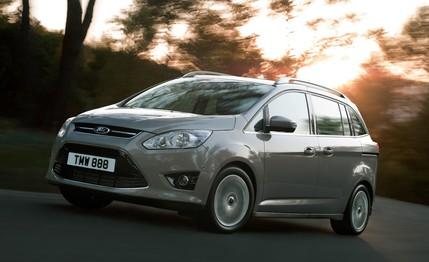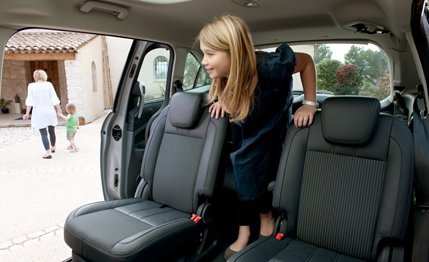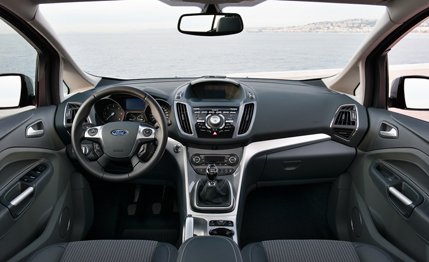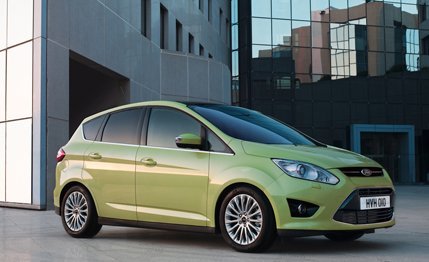
 First Drive Review
First Drive Review
Put aside your mom-mobile prejudices for a moment, and take a look at Ford’s latest attempt at a minivan, the C-Max. Coming here in early 2012, our C-Max is called the Grand C-Max in Europe; over there, the plain C-Max name is applied to a shorter, five-seat version, which we won’t be getting. Both share underpinnings with the 2012 Focus, but the wheelbase of the Grand is stretched by 5.5 inches, to 109.8.
If you’ve already looked at the pictures, you’ve noticed that the C-Max has two sliding doors. By most popular definitions, this makes it a minivan, the lamest of automotive descriptors. Ford, however, is not worried that the C-Max will be uncool. Jim Farley, Ford’s V-P of global marketing, service, and sales, believes the Millennial Generation will make different choices than did its parents. The SUV boom was fueled in part by an aversion to boxy minivans. But the kids that grew up in those SUVs never grew to loathe the minivan as the generation before them did. Thus, the C-Max target buyer sees sliding doors as a convenience—at least that’s what Ford hopes. Whatever customers ultimately decide, the C-Max differs from modern minivans in a few ways. For starters, it’s smaller, more the size of the Mazda 5 than the Honda Odyssey. At 178.0 inches long, the C-Max is two feet shorter than the Honda and 3.5 inches shorter than the Mazda. The C-Max has a wagonlike two-box silhouette instead of the monobox-on-wheels look of modern minivans.


The C-Max officially holds seven passengers, but the seating configuration is best described as five-plus-two. The two most rearward seats lack headroom for adults—although they would be adequate for short trips—but smaller children should fit fine. Keeping the third row folded keeps cargo capacity reasonable, as the van accommodates 25 cubic feet behind the second row; only three cubic feet remain in seven-passenger mode. Fold every seat, and a magnetic cover flops over the stowed seatbacks to create a flat load floor and deliver 60 cubes of storage.
For those who need all three rows, the sliding second row is home to the C-Max’s best trick, whereby the center seat can be stored under its passenger-side neighbor. You simply slide the middle perch forward (the second-row bench is split 40/20/40), pop up the outboard seat’s bottom cushion, and flip the middle seat into place. This allows access to the third row without folding the second forward; child seats can then be left installed in the middle row without losing the versatility of the rearmost seats.
The interior materials in the top-of-the-line Platinum trim level we drove on our preview were excellent, with high-quality plastics and a pleasing amount of aluminum-look trim. The instrument panel is nearly identical to that of the upcoming Focus, which means it packs more character and excitement in its dashboard than most minivans do in their entirety.


As mentioned above, the C-Max won’t be coming to the United States until early 2012. With the final North American product so far out, there are some details Ford has yet to reveal. The company tells us the U.S.-market C-Max will be powered by a 1.6-liter EcoBoost turbocharged four making 148 hp and 177 lb-ft (199 lb-ft with a Porsche-like temporary-overboost function); other engine options haven’t been confirmed, including the possibility of a 2.0-liter EcoBoost. European models get a higher-output, 177-hp version of the EcoBoost, as well as two diesel engines and a naturally aspirated 1.6-liter pulled from the Fiesta. It is unlikely that the naturally aspirated engine will be offered here, and the diesels would probably be too expensive. Ford is strangely quiet on the topic of transmissions, other than saying there won’t be a manual for our market. We’ll get a six-speed automatic, but Ford won’t say whether that transmission is a version of its dual-clutch PowerShift or a conventional autobox. Based on our experience with the PowerShift in the Fiesta, either option will give the same basic driving experience—smooth, but slow to change gears.


Our preview gave no opportunity to drive the C-Max exactly as it will appear here, although we were able to cobble together an impression from the two vehicles available to us: a Grand C-Max (our C-Max) fitted with a diesel engine and the dual-clutch gearbox, and the smaller, Euro C-Max with the EcoBoost engine. The EcoBoost offers good low-end torque and minimal turbo lag. We expect the larger van bound for our shores to turn in a 0-to-60-mph time just below 10 seconds. Handling is good, albeit with the “for a tall wagon” disclaimer, but anyone used to driving small SUVs or larger minivans will be impressed with the carlike characteristics. When our C-Max goes on sale, the summer tires we sampled will be swapped for all-seasons, but the ride and handling targets are the same. We’ve heard that story before, and in the end, the Fiesta didn’t turn out quite as lively as its European twin. But the C-Max should fare better, if only because our expectation of driving thrills in a people mover is pretty low.
How about fuel efficiency and cost? Ford’s focus group (no pun intended) said it would be really happy with 30 mpg highway. That would top the automatic Mazda 5’s by 3 mpg. As for price, the Mazda starts just above $20,000 with an automatic and tops out at nearly $30,000. Ford representatives said the C-Max will come well equipped for $25,000. It remains to be seen how much of the C-Max’s potential is realized when it arrives stateside. But it’s safe to say we haven’t been looking forward to a minivan this much in a long time.